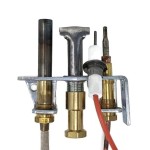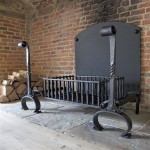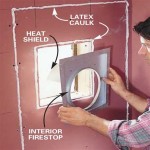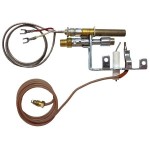How To Install Natural Gas Fireplace Logs
Installing natural gas fireplace logs offers a convenient and aesthetically pleasing alternative to traditional wood-burning fireplaces. This process involves carefully setting up the gas supply, arranging the logs for optimal flame display, and ensuring all components are properly connected for safe and efficient operation. This article provides a comprehensive guide to installing natural gas fireplace logs, outlining the necessary steps and safety precautions.
Before commencing the installation process, it is crucial to understand the overall system. Natural gas fireplace logs operate by directing natural gas through a burner, which then produces flames that are dispersed among the ceramic or refractory logs. These logs are designed to emulate the appearance of burning wood, providing a realistic fireplace ambiance without the associated mess and labor of managing a wood fire. The system typically includes a gas valve, a burner assembly, a set of decorative logs, and sometimes a remote control or ignition system.
Proper planning and preparation are paramount for a successful installation. This includes verifying compatibility with the existing fireplace and gas supply, gathering the necessary tools and materials, and thoroughly reviewing the manufacturer's instructions. Failure to adequately prepare can lead to installation errors, gas leaks, or unsafe operating conditions.
Key Point 1: Preparation and Safety Precautions
Prior to initiating the installation, meticulous preparation is required. This involves several critical steps to ensure a safe and effective process. First and foremost, it is essential to confirm that the existing fireplace is compatible with natural gas logs. This means checking the fireplace dimensions to ensure that the log set will fit comfortably without obstructing the gas burner or venting system. Furthermore, the natural gas supply line must be properly sized and capable of delivering the necessary gas pressure for the log set. Consult with a qualified gas technician to verify the gas supply's adequacy.
Safety precautions are of utmost importance. Before starting any work, shut off the gas supply to the fireplace at the main gas valve. This will prevent accidental gas leaks during the installation process. Additionally, disconnect the electrical power to the fireplace if applicable. It is advisable to wear appropriate personal protective equipment (PPE), including safety glasses and gloves, to protect against potential hazards such as sharp edges or gas leaks.
Gather all the necessary tools and materials before beginning the installation. These typically include: pipe wrenches, pipe sealant approved for natural gas, a level, a screwdriver set, a drill (if modifications are needed), a gas leak detector solution (soapy water is a common alternative), and the natural gas log set itself. Review the manufacturer's instructions for the log set, ensuring that you understand the recommended installation procedures and any specific requirements.
Verify that the fireplace chimney is clean and free of obstructions. A blocked chimney can prevent proper ventilation, leading to carbon monoxide buildup inside the home. If necessary, hire a professional chimney sweep to inspect and clean the chimney before installing the log set.
Inspect the existing gas valve and burner assembly for any signs of damage or corrosion. If any issues are detected, replace these components before proceeding with the log set installation. Using faulty components can compromise the safety and performance of the fireplace system.
Key Point 2: Installation Process
The installation process is a sequential series of steps that must be followed carefully to ensure proper functionality and safety. The process typically begins with connecting the gas supply line to the burner assembly.
First, apply pipe sealant to the threads of the gas fittings. Use a sealant specifically designed for natural gas applications. This sealant creates a tight seal, preventing gas leaks. Connect the gas supply line to the gas valve on the burner assembly, tightening the fittings securely with pipe wrenches. Avoid overtightening, as this can damage the fittings and compromise the seal.
Next, position the burner assembly inside the fireplace. Ensure that the burner is level and centered within the firebox. Use a level to verify that the burner is sitting evenly. If necessary, use shims to adjust the height and ensure a level surface. A level burner is essential for even flame distribution.
Once the burner is properly positioned, it is time to arrange the decorative logs. Each log set comes with specific instructions for log placement. Following these instructions is critical for optimal flame appearance and safe operation. The logs should be positioned so that they do not obstruct the burner ports or interfere with the flow of gas and air. Proper log placement is crucial for achieving a realistic flame pattern and preventing the buildup of carbon monoxide.
After arranging the logs, double-check all gas connections for leaks using a gas leak detector solution. Apply the solution to all fittings and joints. If bubbles appear, it indicates a gas leak. Tighten the fittings further or reapply pipe sealant as needed until the leaks are resolved. Never use an open flame to check for gas leaks. This is extremely dangerous and could lead to an explosion.
Finally, test the ignition system. Turn on the gas supply and attempt to ignite the burner. If the burner does not ignite immediately, consult the manufacturer's instructions for troubleshooting tips. Some systems may require purging air from the gas line before ignition can occur.
Key Point 3: Post-Installation Checks and Maintenance
Following the installation, several critical checks must be performed to ensure the system is functioning correctly and safely. Additionally, a regular maintenance schedule will help to prolong the life of the log set and maintain its optimal performance.
After the initial ignition, observe the flame pattern. The flames should be evenly distributed across the burner surface and should not impinge directly on the logs. If there are uneven flames or hot spots, adjust the log placement accordingly. An uneven flame pattern can indicate a problem with the gas supply or burner assembly.
Monitor the fireplace for any unusual odors or sounds. A faint gas odor could indicate a leak that was not detected during the initial leak test. A hissing sound could also indicate a gas leak. If any of these symptoms are present, immediately shut off the gas supply and contact a qualified gas technician for further assistance.
Schedule regular maintenance to keep the log set operating efficiently. This includes cleaning the burner assembly and logs to remove any dust or debris that may have accumulated. Consult the manufacturer's instructions for recommended cleaning procedures. A clean burner assembly will ensure optimal flame distribution and prevent the buildup of carbon monoxide.
Annually, have a qualified gas technician inspect the entire fireplace system, including the gas supply line, burner assembly, and venting system. This inspection will help to identify any potential problems before they become major issues. A professional inspection can also ensure that the system is operating safely and efficiently.
Finally, ensure that a carbon monoxide detector is installed in the home and that it is functioning properly. A carbon monoxide detector is an essential safety device that can alert occupants to the presence of this odorless, colorless, and potentially deadly gas. Test the detector regularly to ensure that it is working correctly.
By following these detailed instructions and adhering to all safety precautions, the installation of natural gas fireplace logs can be a safe and straightforward process, providing years of comfortable and aesthetically pleasing fireplace enjoyment.

How To Select And Install A Gas Fireplace Log Set Fireplaces Direct Learning Center

How To Select And Install A Gas Fireplace Log Set Fireplaces Direct Learning Center

How To Put In A Gas Log Set For Fireplace

What You Need To Know About Gas Fireplace Logs Fireplaces Direct Learning Center

How To Install A Gas Log Fireplace Ask This Old House

How Long Do Gas Logs Last To Replace Fireplace

How To Install A Ventless Natural Gas Fireplace

Vented Gas Logs Heater Or Decorative Bart Fireside

Glowing Embers For Fireplace Mother Daughter Projects

How To Install A Gas Log Fireplace Ask This Old House








